America's Corporate Art by Christensen Jerome;

Author:Christensen, Jerome;
Language: eng
Format: epub
Publisher: Stanford University Press
Published: 2011-03-14T04:00:00+00:00
Figure 3.13
As Walling decries the decline of the Tredway Corporation to his colleagues before the final ballot, he laments that when Bullard lost faith in the future his prideful aloofness made him insensitive to the pride that the company must have in itself. Suddenly, Walling grabs one of the conference-room side tables and brandishes it as a shameful example of the stuff turned out in the cheap KF line. “We’re now doing things like this,” Walling contemptuously declares. He ferociously yanks off a leg, tosses the table aside, and roars, “This is what Tredway has come to mean” (Figure 3.13). The eruption transfixes his colleagues, who from that moment on are swept along to the election of Walling as president. Larrabee and Riesman dismiss Walling’s “frenzied” behavior as throwing “another temper tantrum,” even though, as expert sociologists and commentators on popular culture, they must have known that there have been few if any business films since Skyscraper Souls (MGM, 1933) that more explicitly represent the tactical manifestation of charisma deployed to claim authority. But if it is charisma that Walling displays, it is not charisma of the Weberian kind. Walling’s “frenzy” is not genuine. The audience in the theater knows what the audience in the executive suite does not, that Walling is imitating an action of Bullard’s that he learned about earlier in the day from the line foreman down at the plant. In the course of lamenting the decline in the quality of the Tred-way product, the foreman had recounted an incident when Bullard grabbed a cheap piece of furniture as it passed him on the assembly line and angrily broke it into pieces. Bullard committed an act of unpremeditated violence. He lost his temper then as Walling did later with Julia Tredway. If Bullard’s anger was directed at anyone, it could only have been directed in impotent rage at himself for compromising his own standards of quality. Walling, however, performs an extemporaneous act of violence by imitating Bullard. Unlike Bullard he is effective. Whatever his rapt colleagues may think or his wife may fear, Walling is not possessed by Bullard. By breaking off the frail table leg, Walling adroitly ironizes Bullard’s gesture, which he now uses to demonstrate what a declining Tredway has come to mean over the recent years of Bullard’s own management. He boldly highlights the importance of that act as the rupture of the trammels of the cash nexus by embracing the “creative destruction,” which, according to Joseph Schumpeter, drives capitalism by “revolutioniz[ing] the economic structure from within.”39
Revolution is, of course, Schumpeter’s and Weber’s term of choice, not Walling’s. As a designer and engineer, he prefers to exhort his followers to technical innovation. As a manufacturer he must orient the company to the customers whose needs it must satisfy. As a marketer, he must make the customers understand what their needs are. His acting in the film combines manufacturing and marketing: he has gathered resources, arranged them, conducted experiments, improvised when necessary, and constructed a
Download
This site does not store any files on its server. We only index and link to content provided by other sites. Please contact the content providers to delete copyright contents if any and email us, we'll remove relevant links or contents immediately.
| Coloring Books for Grown-Ups | Humor |
| Movies | Performing Arts |
| Pop Culture | Puzzles & Games |
| Radio | Sheet Music & Scores |
| Television | Trivia & Fun Facts |
The Kite Runner by Khaled Hosseini(4944)
Gerald's Game by Stephen King(4366)
Dialogue by Robert McKee(4156)
The Perils of Being Moderately Famous by Soha Ali Khan(4061)
Story: Substance, Structure, Style and the Principles of Screenwriting by Robert McKee(3325)
The 101 Dalmatians by Dodie Smith(3296)
The Pixar Touch by David A. Price(3202)
Confessions of a Video Vixen by Karrine Steffans(3098)
How Music Works by David Byrne(2958)
Fantastic Beasts: The Crimes of Grindelwald by J. K. Rowling(2837)
Slugfest by Reed Tucker(2796)
Harry Potter 4 - Harry Potter and The Goblet of Fire by J.K.Rowling(2796)
The Mental Game of Writing: How to Overcome Obstacles, Stay Creative and Productive, and Free Your Mind for Success by James Scott Bell(2763)
4 - Harry Potter and the Goblet of Fire by J.K. Rowling(2526)
Screenplay: The Foundations of Screenwriting by Syd Field(2428)
Scandals of Classic Hollywood: Sex, Deviance, and Drama from the Golden Age of American Cinema by Anne Helen Petersen(2391)
Wildflower by Drew Barrymore(2378)
The Complete H. P. Lovecraft Reader by H.P. Lovecraft(2366)
Casting Might-Have-Beens: A Film by Film Directory of Actors Considered for Roles Given to Others by Mell Eila(2300)
